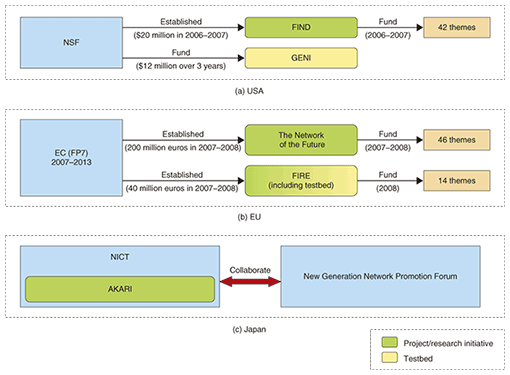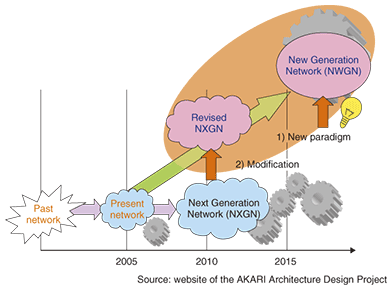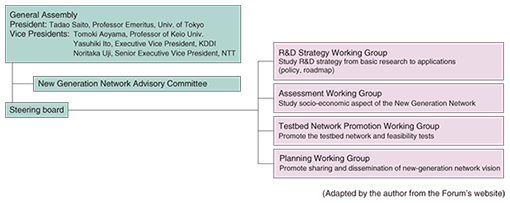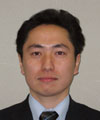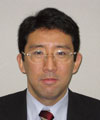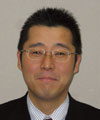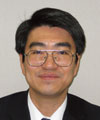 |
|||||||||||||||||||||
|
|
|||||||||||||||||||||
|
Special Feature: Design Concepts for New Generation Carrier Networks Vol. 7, No. 5, pp. 27–32, May 2009. https://doi.org/10.53829/ntr200905sf2 R&D Trends for Future Networks in the USA, the EU, and JapanAbstractThis article introduces trends in the research and development activities for future networks in the USA, the EU, and Japan. Research initiatives on future networks have been launched by the US National Science Foundation, the European Commission, and other organizations. In Japan, research on future networks is being promoted through the leadership of the National Institute of Information and Communications Technology.
1. Rising R&D activities for future networksWith the Internet now recognized as a social infrastructure, it is being widely used to provide a diverse range of services, but its inherent limits have begun to be noticeable. To discuss and seek fundamental solutions to these limits, starting with a clean slate, several countries have launched research and development projects on future networks. This article analyzes and considers the features of representative projects in the USA, the EU, and Japan. 2. Activities in the USA and the EU2.1 USAWell over thirty years have passed since the birth of the Internet, and some people have begun to point out the limits inherent to the existing Internet in terms of security, quality of service, and stability. In the USA, a clean-slate Internet architecture has been discussed since around 2000 [1]. This aims to reexamine the design concept of the existing Internet and build a future network from scratch. In response to this movement, the National Science Foundation (NSF) started a research initiative called FIND (Future Internet Design) to aid research on an entirely new network architecture and its technical components. Shackled by the constraints of the Internet protocol (IP), on which it is based, the existing Internet is very restricted in its ability to incorporate innovative technologies. To solve this problem, the NSF is planning to construct GENI (Global Environment for Network Innovations), a testbed for the development of an entirely new network architecture and its technical components (Fig. 1(a)).
2.1.1 FINDSince 2006, FIND has been mainly funding universities that pursue promising research themes related to future networks. Two distinctive features of this funding are that first FIND does not specify the overall picture of future networks and does not identify priority research areas at the proposal invitation stage and second it encourages fundamental studies and does not demand short-term results. FIND’s vision for the future network is as follows:
2.1.2 GENIGENI is currently at the design stage. Construction of the testbed will start in 2010 or 2011 and finish around 2015. It will use programmable routers to allow new protocols and network architectures to be evaluated on it. The testbed will be connected to wireless networks to allow experiments with sensors and a variety of other terminals. In addition, slicing technology will be applied to allow a single physical network to be divided into multiple logical networks. This will enable researchers to share GENI’s network resources efficiently [2]. 2.2 EUThe European Commission (EC), the executive branch of the European Union (EU), has launched FP7 (Seventh Framework Programme), an R&D program designed to boost Europe’s international competitiveness and technical expertise. In the field of information & communications technology (ICT), FP7 allots the largest budget to the pervasive and trusted network and service infrastructures in the hope of creating new industrial/service opportunities. In 2007, two research initiatives relevant to this were started in the ICT field: The Network of the Future, which is designed to enable Europe to reinforce industrial leadership in both the wired and wireless fields, and FIRE (Future Internet Research and Experiment), which is designed to aid the construction of testbeds and explorative long-term research activities (Fig. 1(b)). 2.2.1 The Network of the FutureThe Network of the Future initiative has been funding promising research themes since 2007. It has two features. One is that the call for proposals did not specify the overall picture of future networks nor did it identify priority research areas at the proposal invitation stage. The second is that, with many industrial enterprises participating, the scope of work encompasses not only fundamental research themes but also themes close to application and commercial implementation in such areas as high-speed wireless communication. The Network of the Future calls for proposals to achieve the following target outcomes [3]:
2.2.2 FIREFIRE involves both the construction of testbeds and support for long-term research activities with a view to going beyond desk study of innovative ideas on the future Internet and validating the concept and socio-economic influences on users [4]. As with The Network of the Future, many enterprises are participating in FIRE, in addition to universities. Its funding began in the spring of 2008 and actual research was initiated by the summer of the same year. 3. Activities in JapanWith a view to strengthening its international competitive edge, Japan has started activities to develop a New Generation Network based on new design concepts and technologies rather than building on existing technologies. In 2006, the National Institute of Information and Communications Technology (NICT) launched the “AKARI Architecture Design Project” (known simply as AKARI) with the aim of establishing the architecture for the new-generation network and developing a network design concept based on that architecture. In addition, the New Generation Network Promotion Forum was formed in 2007 (Fig. 1(c)) to accelerate the study through concerted efforts involving academia, government, national institutes, and industry. 3.1 AKARIThe approach to the future network adopted in AKARI is to design and build an ideal network starting with a clean slate, free from existing constraints (Fig. 2). In 2007, AKARI announced the “New Generation Network Architecture—AKARI Conceptual Design” [5], which addressed problems facing existing networks, such as the increasing complexity in the layer structure of protocols and the difficulty in maintaining the reliability of an overall system, and identified 11 requirements for the design of the future network, such as large capacity, scalability, openness, robustness, safety, and diversity. Furthermore, it proposed a network based on a new design concept and on optical communication technology, such as optical packet switching, which can achieve greater capacity and lower cost than current electronic packet switching. The conceptual design also identifies optical switching and optical buffering as important technical components for implementing this network. AKARI plans to complete AKARI New Generation Network Design Diagrams by fiscal 2011 and to complete the development of the technologies for building the network by fiscal 2016.
3.2 New Generation Network Promotion ForumThe membership of the New Generation Network Promotion Forum (Fig. 3) includes the Ministry of Internal Affairs and Communications, domestic carriers (e.g., NTT and KDDI), and many enterprises and universities. The Forum aims to promote strategic and comprehensive R&D on the New Generation Network without being constrained by existing networks. It will collaborate with AKARI and other activities related to the new-generation network being pursued by NICT to develop Japan’s overall strategy for the future network.
4. Features of R&D projects in the USA, the EU, and JapanThe features of the abovementioned R&D projects being undertaken in the USA, the EU, and Japan are analyzed below with a focus on three aspects: research areas, membership, and research approaches. 4.1 Main research areasThe research themes funded by FIND (USA) and The Network of the Future (EU) can be classified into the technical areas shown in Table 1.
Of the 42 themes (as of 2008) funded by FIND, as many as 22 of them (52%) are related to next-generation protocols, followed by 18 (43%) related to the interconnection of heterogeneous networks, and 13 (31%) related to an overlay network. This can be interpreted as reflecting the USA’s intention to solve the problems of the existing Internet by reexamining the very design philosophy of the Internet and studying protocols and architecture. The Network of the Future initiative supports 46 themes (as of 2008). Of these, the majority (25 themes or 54%) is related to high-speed wireless communication while only 6 themes (13%) are dedicated to optical transmission. Although The Network of the Future initiative originally aimed to study both wired and wireless technologies, the set of themes actually funded tilts the balance in favor of wireless technology. Moreover, about 60% of research themes pursued in FIRE (data not shown) are concerned with wireless technology. So, it can be said that a distinctive feature of Europe’s research on the future network is its emphasis on wireless communication. AKARI, on the other hand, considers optical communication technologies as the most important element of the new architecture, so a feature of Japan’s research on the future network is the high priority placed on optical technologies. 4.2 MembershipSince the mission of the NSF in the USA is to promote the progress of science, both FIND and GENI are driven mainly by their university members, and no flagship carriers such as AT&T or Verizon have joined these projects yet. The set of themes for the Network of the Future and FIRE initiatives, both supported by the EU’s FP7, involve collaboration between academia, national institutes and industry, including BT, France Telecom, and other carriers as well as manufacturers. In Japan, research on the future network has been undertaken mainly by NICT and universities, but the establishment of the New Generation Network Promotion Forum has prompted the participation of many enterprises, leading to a national endeavor involving academia, government, national institutes, and industry. 4.3 Research approachesStudies on the future network have just begun. So far, no details of network architecture or technical components envisioned in the initiatives have been worked out, but the general directions of the approach being taken in each region can be characterized as follows:
5. Future developmentsFor Japan to enhance its industrial strength and international competitiveness in the future, it is important that academia, government, national institutes, and industry fully participate in playing their respective roles and lead the world in developing core technologies. NTT Laboratories will press forward with R&D on the future network [6]–[9], and, as a member of the New Generation Network Promotion Forum, will contribute to its quadripartite strategic endeavor. References
|
|||||||||||||||||||||








